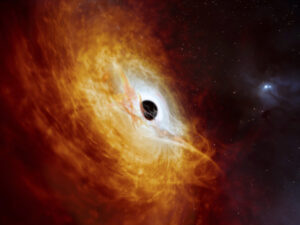
In recent years, the Event Horizon Telescope has let us get up close and personal images of supermassive black holes. In the galaxy M84, we see a hungry giant with a 1.5 billion solar mass of material. In our own Milky Way, we have a 4.3 million solar mass beast that flings stars and gas around in zippy orbits we can watch. These are amazing objects, but they are just plain boring when compared to the supermassive black holes that were active in the early universe.
In a new paper appearing in Nature Astronomy, researchers led by Christian Wolf describe a newly observed black hole that weighs in at 17 billion solar masses and growing. This black hole is eating at least one solar mass of material a day!
Channeling material into the black hole is a truly magnificent accretion disk. Thanks to the laws of physics and the evils of conservation of momentum, it isn’t possible for most things to fall straight into a black hole. Instead, they spiral in as they lose momentum and energy to friction and other forces. If enough material is trying to fall into a black hole at the same time, these accretion disks can get so dense that nuclear reactions and heat can together light them up brighter than their surrounding galaxy. These accretion disks are the stuff of Quasars and Active Galaxies.
In this galaxy, cataloged as SMSS J052915.80−435152.0, temperatures reach 10,000 degrees Celsius, and Wolf explains there is “lightning everywhere and winds blowing so fast they would go around Earth in a second.” The closest we can come to imagining this disk is to think of a hurricane. Only, as Wolf puts it, “This storm cell is seven light-years across, which is 50 percent more than the distance from our solar system to the next star in the Galaxy, alpha Centauri.”
This disk glows with the light of 500 trillion Suns.
Located more than 12 billion light years away, this system is shining from the early Universe. At some point in history, it likely ran low on food, and if we could see it today, it might be sitting quiescent in the heart of a giant elliptical or it might just be casually snacking on its surroundings. It’s hard to know, but it’s fun to imagine.
